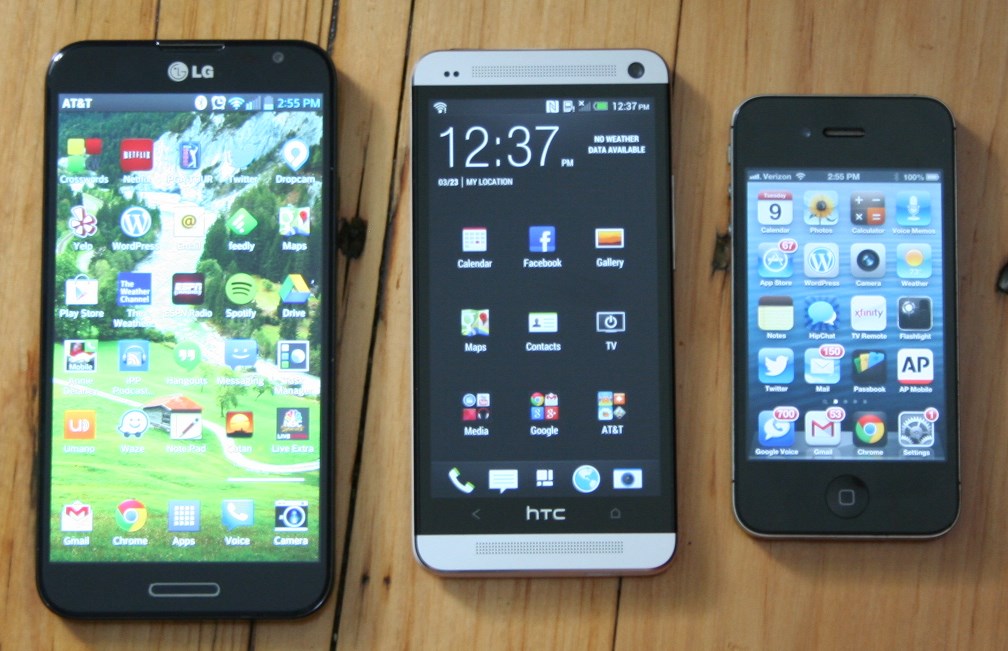I’ve been “reviewing” the LG Optimus G Pro since early May. It’s taken so long for me to write this that the phone’s original $200 selling price has now dropped to $100 on AT&T. I don’t want to send it back, so I’ve been delaying the inevitable. If you’re reading this, though, it means I’ve hit the publish button, wiped my data off the phone and boxed it up for its trip back to AT&T’s headquarters in Dallas. We had a good run.
So, this is a phone for people with giant man-hands who are interested in the Samsung Galaxy Note II but don’t want to spend a lot of money and don’t care about not having the Note II’s signature stylus. The Optimus G Pro and Note II are both similar in size, each with a 5.5-inch screen, but LG’s offering manages to trim the side bezel just enough to make it feel more like a smartphone than a phablet.
Don’t get me wrong: It’s still a huge phone. I can’t hold it in one hand and have my thumb stretch far enough to tap the opposite upper and lower corners of the screen. And though it fits in my pants pockets, it’s not exactly comfortable if I’m riding a bike or bending over to pick something up.
In the below photo, from left to right, are the 5.5-inch LG Optimus G Pro, the 4.7-inch HTC One and the 3.5-inch iPhone 4S.

LG has ticked all but a few of the boxes with this phone. The full-HD (1920×1080) screen is great, the touch keyboard is responsive and can be shifted to either side to accommodate one-handed typing, there’s a physical home button, there’s ample storage (32 gigabytes) with an easy-to-access expansion slot, and the quad-core Snapdragon processor handles Android with ease.
Like most phone makers, LG has lathered its own custom interface over the top of Android. I’ll duck as Android purists whip beer bottles at my head before saying that LG’s interface is actually pretty good. There are plenty of customization options, everything’s relatively intuitive and the added shine doesn’t slow the overall operation of the phone down noticeably. There are a few nice software extras as well, such as the ability to use the phone as a remote for your TV and other home entertainment equipment.
As for the phone’s so-so features, the battery is able to last through an entire day of moderate use, but heavy use wears it down more than I’d like to see with a phone this size. Also, the build quality is at best utilitarian and at worst plasticky. It’s not bad but it’s nothing to write home about. Finally, the camera takes serviceable photos, but color reproduction is a bit on the bland side and low-light images suffer. This isn’t a phone for those of you who want to get creative with your photo-taking; everyone else will find most photos turn out fine, however.
And now to the bad stuff. The speakerphone is bad. It’s arguable the phone’s worst feature. It doesn’t get loud enough and it’s very tinny. Turn the volume up all the way and it has a tendency to crackle. The positioning of the volume buttons on the phone’s left edge is too low, too. LG made way for a customizable quick-launch button to sit in the prime real estate of the upper-left corner of the phone’s bezel instead. I would have gladly taken the volume buttons higher up with the quick-launch button lower down. There’s no HDMI output either. This phone is more than powerful enough to drive content to your TV, but you’ll have to futz with DLNA settings to do so. That’s about it for the cons, though, and the phone’s $100 price tag helps ease the pain substantially.
Bottom line: If you’re looking for a giant smartphone on AT&T, the LG Optimus G Pro beats the Samsung Galaxy Note II thanks to its cheaper price and higher-resolution screen. There are almost certainly other contenders that’ll make their way to market later this year (Galaxy Note III? Something phablet-like from HTC?) but none of them will be priced at $100 out the door.
LG Optimus G Pro [AT&T]

